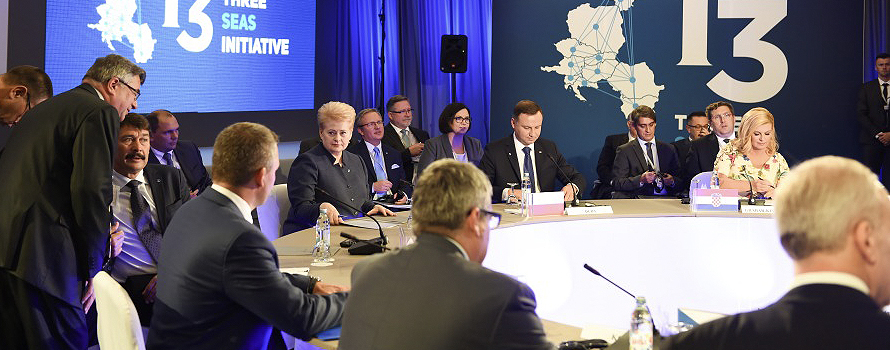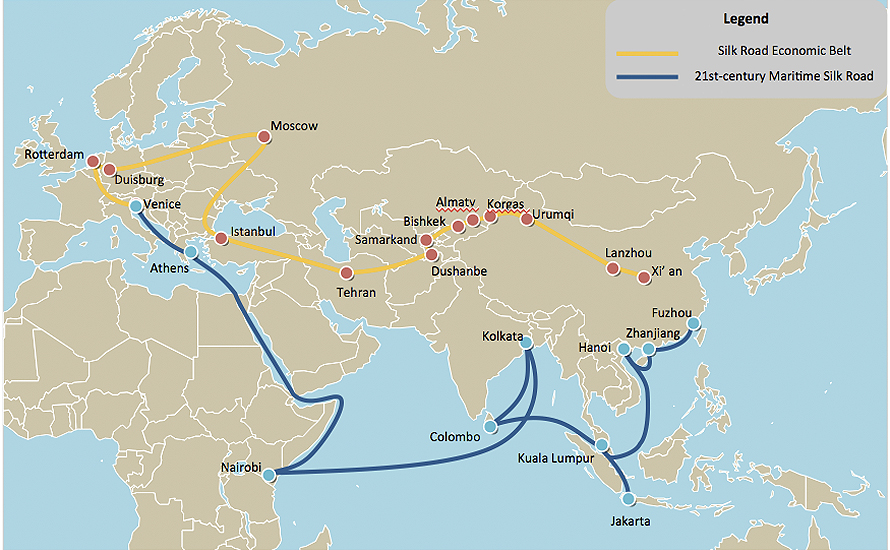Ruta de navegación
Menú de navegación
Blogs
Entries with Categories Global Affairs Logistics and infrastructure .
Introduction to the project cooperation of 12 EU countries located between the Baltic, Adriatic and Black Seas.
In addition to the East-West integration efforts of EU enlargement, a number of North-South linking initiatives have been added between the countries of Central and Eastern Europe, such as the Three Seas Initiative. The goal is aimed at overcoming the road infrastructure deficit and improving connectivity between these nations, which will enhance cooperation in the region and in the EU as a whole.

▲First meeting of the new forum, in the Croatian city of Dubrovnik, in August 2016 [i3].
article / Paula Ulibarrena
What is it and what does it aim to achieve?
It is an initiative of Poland and Croatia that brings together 12 countries located between the Baltic, Adriatic and Black Seas and is therefore also known as the Baltic, Adriatic, Black Sea (BABS) Initiative.
The key goal is promote that these countries of the European Union have greater cooperation in infrastructure development , economic development , economic cooperation and above all in energy resources. Polish President Andrzej Duda expressed the hope that the Three Seas Initiative would contribute to the modernisation, integration and unification of Central Europe, Eastern Europe and the entire European Union.
How and where was this forum born?
Since the fall of the Berlin Wall, much progress has been made towards a united, free and peaceful Europe. The entrance of Central European countries in the European Union and NATO has contributed to the security, stability and prosperity of the entire continent. But this work is far from complete. And the cohesive role of infrastructure will be crucial in achieving this.
For more than half a century, efforts to develop European connections and infrastructure focused on the East-West axis. After the fall of the Wall, governments in the region focused on integrating their economies into Western markets, leaving the development of a North-South interregional infrastructure on the back burner. After decades of disinvestment, a major effort has been made in the last twenty years to catch up: 5,600 kilometres of motorway have been built. But the imbalance between the two Europes is still glaring: a citizen of old Europe has twice as many kilometres of motorway as a citizen of central Europe, average.
|
▲Wikimedia Commons [JayCoop]. |
goal With the aim of reversing status, the presidents of Poland and Croatia, Andrzej Duda and Kolinda Grabar-Kitarović, respectively, launched in 2015 a project for the construction of energy, transport and telecommunications infrastructure in Central Europe. They called it the Three Seas Initiative.
By whom is it formed?
The initiative aims to modernise economic links between the twelve EU nations located between the Baltic, the Black Sea and the Adriatic Sea (Austria, Bulgaria, Croatia, the Czech Republic, Estonia, Hungary, Latvia, Lithuania, Poland, Romania, Slovakia and Slovenia). This region accounts for 28% of the European Union's territory and 22% of its population. But it accounts for only 10% of its GDP.
In 2016, Poland and Croatia were joined by most Eastern European countries: Austria, Bulgaria, Slovakia, Slovenia, Estonia, Hungary, Latvia, Lithuania, Czech Republic and Romania. Thus a north-south axis that, with the exception of Austria, corresponds to the former communist countries.
The so-called Three Seas Initiative held its first session on 25-26 August 2016 in Dubrovnik and ended with a declaration of cooperation on subject economic cooperation, particularly in the fields of energy, transport and communications. In addition to the member states, representatives of the Chinese Ministry of Foreign Affairs and the US Homeland Security committee attended as guests.
The second meeting took place on 6-7 July 2017 in Warsaw, with US President Donald Trump as a guest. In fact, this visit was a slight snub to other EU countries.
The third meeting will take place in Romania in 2018, although the city has not yet been fixed.
How is it financed?
150 billion from the Structural Funds, plus additional money from the Connecting Europe Facility and the European Investment Bank. However, more than 384 billion still needs to be invested in another 2,000 projects to fill in or modernise these corridors.
An investment of this size is beyond the possibilities of public institutions, so infrastructure companies and financial institutions will have to play a key role. Up to now, this subject of financing has been much less important than state contributions. However, the increase in public debt makes it increasingly interesting to have sources that minimise the impact on public accounts.
Screening
Faced with this magnitude of resource requirements, the question arises as to whether Central Europe is really an attractive market for investment. In this respect, two points can be made. This is a region with, firstly, very good economic growth prospects (expected to outpace Old Europe over the next five years), and secondly, with a construction sector that is expected to grow at a rate of 3.1% per annum average (compared to 2.3% for Western Europe), according to data by BMI Research. This is certainly attractive for investors.
The other side of the story is that we are still an emerging region. And, of course, this, in addition to generating reserves, brings with it a higher level of risk. In this sense, we also have very different situations depending on which country in the region we are looking at. For example, Estonia right now is what investors call a "sweet spot", with very high returns and low risk. But it is the only country in the region in this category. There are countries - such as Lithuania, Croatia, Slovakia and Slovenia - where the risks are equivalent to those of Greece or Italy, but the returns are relatively low. And others have the opposite problem: high returns but too much risk.
The experience of those players already present in this area -some of them Spanish, such as Ferrovial, Bankia or BBVA-, shows that although each country has significant peculiarities, there are some common risks. To mention them briefly: lack of political support; regulatory regimes that lack transparency; very complex contracting processes - such as PPPs and concessions -; lack of projects with the necessary level of maturity to arouse investor appetite, and the lack of skill in the public sector in these countries to take advantage of private-sector funding schemes, among others.
In an increasingly competitive and global Economics , the prosperity and well-being of a united Europe will depend on how quickly it adapts to today's world. In that process, building a connected, safe, affordable and sustainable transport network connecting the EU from north to south is core topic. Doing so will have a direct impact on increasing the competitiveness of all European countries, and consequently on the economic growth of Europe as a whole.
The project 'One Belt-One Road' aims to consolidate China's rise as a superpower.
Xi Jinping's ambitious initiative to connect China to the rest of the Eurasian continent may prove costly and difficult. But unlike the overland route through the Central Asian republics, the sea route may not take long to become a reality on certain stretches, as China has already built some ports along part of the route.

▲The land and sea routes of the Chinese initiative [yourfreetemplates].
article / Jimena Puga Gómez [English version].
Following Chinese President Xi Jinping's 2013 revitalisation of the ancient Silk Road speech , the initiative that started as an idea has become the Beijing government's biggest economic challenge: a revolution that, if realised, will change the Asian continent's passenger, freight and hydrocarbon transport infrastructure, as well as high-tech. Dubbed OBOR-OneBelt-One Road, the plan is intended to be the core topic of China's rise as a regional superpower.
The OBOR initiative is a grand plan to reshape China's strategic environment, project Beijing's economic power, secure the communist country's access to energy and mineral supplies, and boost economic growth in the west of the People's Republic. OBOR seeks to achieve these goals by fostering greater and faster connectivity between China and Europe through intermediate points in Central, West and South Asia, as well as with Russia.
For its part, the maritime route that will form one of the pieces core topic of the OBOR initiative, also known as the Silk Road of the 21st century, counts on the fact that seven of the ten largest ports in the world are in China and, as is well known, these infrastructures make the Asian giant an important exporter of port services management .
The Eastbound Maritime Silk Road will start in Fujian province and pass through Guangdong, Guangxi and Hainan, before heading south to the Strait of Malacca. From Kuala Lumpur, the Route will continue to Kolkata and Colombo, then cross the rest of the Indian Ocean towards Nairobi. From there, it will travel through the Horn of Africa, seeking to cross the strategic Gulf of Aden to the Red Sea. Beijing's plan aims to create sufficient infrastructure to allow Chinese ships to safely reach the Mediterranean after sailing through the Suez Canal. But the People's Republic's ambition does not stop at the EU's doorstep, as China wants to reach Athens via the Aegean and from there to Venice, where it will look for land routes to move its goods throughout the Union. Chinese investment has focused, among other things, on the port of Piraeus, with a new logistics centre, and on the development of a network of logistics infrastructures through the Balkans and Hungary.
The South Pacific has also been included in this strategic route map devised in Beijing. Thus, the maritime Silk Road has two routes. The first, as mentioned above, originates on China's east coast and, via the South China Sea, aims to establish strategic control of the Spratley Islands, the Strait of Malacca and the entire Indo-Pacific area, including the Bay of Bengal, in order to reach the heart of Europe. The second sea route will also cross the South China Sea to direct its ships to the coastal ports of the South Pacific. In this way, China would also control the routes for the essential raw materials that come from Latin America.
Although this is a long-term economic project deadline , the Chinese government has already begun the construction of certain infrastructures and the necessary negotiations with different countries. A clear example is Germany. The European Union is China's largest trading partner , while the People's Republic of China is the EU's second largest provider . sample . Germany is a country that not only enjoys an excellent reputation as a reliable partner in China, but is also regarded as "Europe's trade gateway". test This is why, at a meeting in Duisburg, the world's largest inland port and an important transport and logistics hub in Europe, Chinese President Xi Jinping proposed to Germany "to work together to realise the ambitious project of the revival of the economic belt of the new Silk Road of the 21st century". Germany and China are currently connected by the Chongqing-Xinjiang-Duisburg international railway line.
The ports built by China at Hambantota and Colombo in Sri Lanka, the China-Suez Economic and Trade Cooperation Zone in Egypt, Kazakhstan's negotiation of the right to clear its imports and exports through the Chinese port of Lianyungang, and a new alliance between ports in China and Malaysia are further examples of China's ability to leverage its new skill as a port moderniser and manager to support its strategy.
The New Silk Road initiative is a project that will require multi-billion dollar investments in order to build smooth, safe and efficient transport infrastructures. The effects of this economic network ensure benefits not only for China, the leader of the OBOR initiative, but also for all countries affected by it. However, the financing of project is still a question mark that needs to be clarified.
Showing range 11 - 12 of 12 results.

